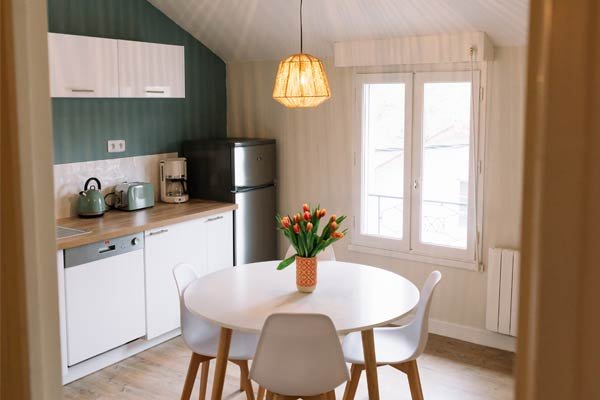There’s been a notable trend that focuses on downsizing our expensive and wasteful lifestyles. Examples include zero-waste and low-waste living, minimalism, cruelty-free trends, and tiny living. Popular opinion seems to be that we need to start focusing on our quality of life rather than what we possess and how much we’ve spent on it.
Two of these trends that go very well together is minimalism and tiny living. In fact, the two share similar principles and habits.
Before we look at what these two lifestyle choices have in common, let’s go a little deeper into each individually. To understand precisely how these two concepts work together, we need to analyze them separately first.
What Are Tiny Homes and Tiny Living?
First, what makes a tiny home a “tiny” home? On average, an American home is around 2,600 square feet. A tiny house, on the other hand, is approximately 100 to 400 square feet.
Why do people choose tiny living? Let’s look at a few of the top reasons:
- After the initial investment, it’s often a lot more affordable.
- It makes it easy to travel and take your home with you.
- It’s essential to focus on quality rather than quantity to conserve space.
- They are scientifically proven to be more eco-friendly.

Those are all excellent reasons to get in on the tiny living trend!
Keep in mind that these homes aren’t always glamorous. It can be small, hot, and cramped. Moreover, owners often face challenges like mold and zoning laws. This lifestyle requires a lot of commitment, but you’ll likely find it highly rewarding if it suits your philosophy not to waste space.
What’s Minimalism and Its Fundamental Principles?
Minimalism is built on a few principles:
- Simplifying, decluttering, and organizing your life
- Focusing on your experiences
- Detaching your self-worth from monetary possessions
- Minimizing distractions and projects to focus on priorities
- Food preservation and curbing waste
- Making a lifestyle change by choice, whether it’s easy or not
You’ll find some articles claiming dozens of these “principles” to follow, but they’re all built on the same “cardinal rules” listed above.
What These Lifestyles Have in Common
You might already be seeing why tiny living and minimalism work so well together. However, let’s take a more in-depth look at what these lifestyles have in common below.
Simplicity
This is probably the easiest commonality to spot. Minimalism and tiny living focus on reducing, decluttering, and simplifying. While tiny living’s focus is primarily on reducing your living space, clutter, and carbon footprint, minimalism takes it a few steps further.
With minimalism, you’ll also be encouraged to simplify other parts of your life, such as setting goals and priorities. For example, instead of focusing on five or six different career goals, such as getting a raise, working for yourself, and getting a bonus, pick only one. Then, devote all your time and effort to attaining that one goal.
Simplicity is one of the critical elements that make up the foundation of both lifestyles.
More Freedom
Both tiny living and minimalism focus on freedom, albeit two different kinds. With minimalism, you’ll be freeing yourself from consumerism and the external validation of your self-worth, which is usually dependent on your possessions.
On the other hand, tiny living is more about financial freedom and traveling with your home. Statistically, 55% of tiny homeowners have more savings than the average American, and 89% have less debt. This freedom is also complementary to minimalism’s focus on experiences.
Eco-Friendly
Many blogs and articles have begun to use low-waste, zero-waste, and minimalism interchangeably. Even though these are all independent movements, they do have several overlapping features. Most importantly, they all encourage a form of environmentally friendly living, and the same can be said for tiny living.
Living in a tiny house can reduce your carbon footprint dramatically. Because you’re reducing the cost of housing, transportation, food, goods, services, and utilities, your footprint can shrink by as much as 45%.
Minimalism also works in harmony with eco-friendly principles. By curbing how much you buy, you’ll automatically be reducing the waste you produce. You’ll also be far more aware of what you’re bringing into your life, including plastic bags, boxes, and other waste that’s just going to end up in a landfill.
It’s Not an Easy Lifestyle Choice
Both lifestyles come with their difficulties, and if you’re not entirely committed, they can overcome you.
For example, tiny homes pose a lot of unique challenges when it comes to space. Your closet might be little more than a crawlspace, and your toilet might share the same area as your shower. Appliances are smaller, and bedrooms are usually little more than tiny, hot lofts – not ideal if you struggle with claustrophobia. Mold, breakage while traveling, and fuel are all challenges you’ll face as a small homeowner.
Similarly, minimalism also comes with a set of obstacles. We live in a culture that promotes consumerism as something that’s essential as breathing. Saying no to an item in a store can be extremely difficult, and we often feel bad for doing so. Why? Because we have been conditioned to judge our worth by our purchases, rather than our quality of life.
That’s, perhaps, one of the most important things both lifestyles have in common. They force us to focus on the quality of our lives, and the worth of our memories and choices, rather than what we can afford to spend our money on.
Final Word
Both lifestyles work perfectly well independently, but merging tiny homes and minimalism creates a powerful combination. You can gain more freedom, whether traveling around in your tiny house or saying no to something you don’t need. Additionally, minimalism and tiny homes are beneficial for the environment.
Both lifestyles have their challenges, but many folks will testify about how much their lives have changed for the better by adopting them. Who knows, perhaps you’ll love becoming a traveling, tiny living minimalist, too!












